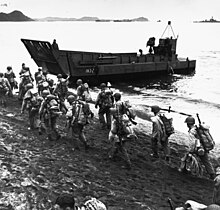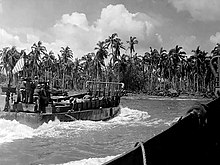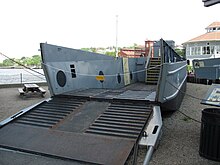|
Landing craft mechanized   The landing craft mechanized (LCM) is a landing craft designed for carrying vehicles. They came to prominence during the Second World War when they were used to land troops or tanks during Allied amphibious assaults. VariantsThere was no single design of LCM used, unlike the landing craft, vehicle, personnel (LCVP) or landing craft assault (LCA) landing craft made by the US and UK respectively. There were several different designs built by the UK and US and by different manufacturers. The British motor landing craft (MLC) was conceived and tested in the 1920s and was used from 1924 in exercises. Nine were in service at the start of the war. It was the first purpose built tank landing craft. It was the progenitor of all subsequent LCM designs. LCM (1) The landing craft, mechanised Mark I, was an early British model. It was able to be slung under the davits of a liner or on a cargo ship boom with the result that it was limited to a 16-ton tank.[1][clarification needed] The LCM Mark I was used during the Allied landings in Norway (one alongside the MLCs),[2] and at Dieppe and some 600 were built.
LCM (2)The first American LCM design, from the US Navy's Bureau of Construction and Repair. Approximately 150 were built by American Car & Foundry and Higgins Industries.
LCM (3) There were two designs:
Capable of carrying 120,000 lb (54,000 kg) of cargo
In appearance very similar to the LCVP which Higgins Industries also constructed, with a 10-foot (3.0 m) wide load area at the front and a small armoured (1/4 inch steel) wheelhouse on the aft decking over the engine room. A vessel claiming to be a Higgins LCM-3 is on display at the Battleship Cove maritime museum in Fall River, Massachusetts, however this vessel has the superstructure and overall length of an LCM-6.[5] Another Higgins LCM-3 is displayed at the Museo Storico Piana delle Orme in Province of Latina, Italy, 18 miles east of Anzio.[6]
LCM (4)In 1943 and 1944, seventy-seven LCM(4)s were built.[7] Externally, the LCM(4) resembled a late model LCM(1) but inside the pontoon special bilge pumps and ballast tanks allowed the LCM(4) to alter trim to increase stability when partially loaded. LCM (5)British model of LCM LCM (6)The LCM (6) was an LCM (3) extended by 6 feet (1.8 m) amidships.
Many LCM-6s were later adapted for the Mobile Riverine Force in the Vietnam War. Some were modified as armored troop carriers (ATCs or "Tangos"), others became "monitors" with 105 mm guns, "Zippos" with flamethrowers or "Charlie" command variants. A few LCMs were converted to lay and repair hoses for tankers equipped with the offshore petroleum discharge system (OPDS).[8] LCM (7)British model of LCM LCM (8) General characteristics, LCM 8 Type
Operators
Former operatorsSee also
Notes
References
External links |
Portal di Ensiklopedia Dunia